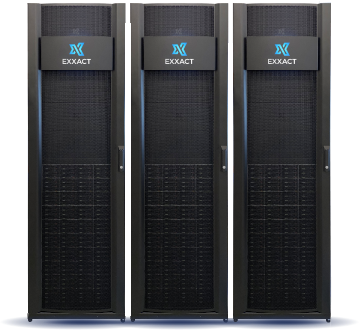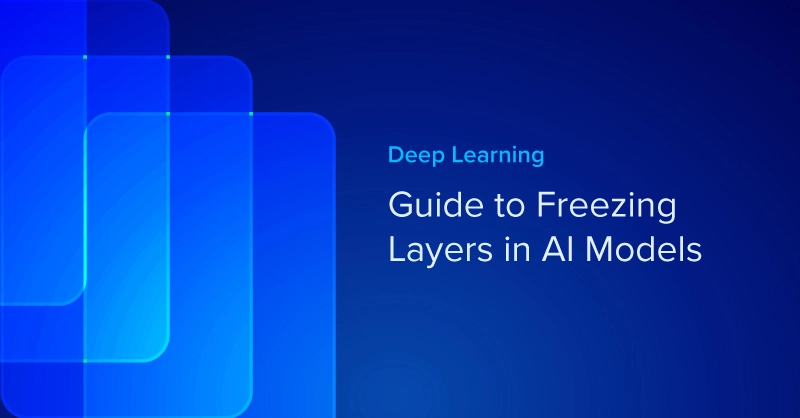
Introduction
Clusters of compute nodes are no strangers to the data center. However with the advancements in GPU accelerated general purpose computing, a wide variety of workloads can be run on a standalone workstation.
But with computing projects that require more than the average computing, a computing cluster allows multiple servers to compute together as a unified system, distributing the workload increasing computational efficiency, and enabling the viability of large complex projects.
Cluster computing isn’t just about pooling resources; it’s about transforming independent systems into a cohesive unit capable of tackling the most demanding tasks. We’ll delve into what cluster computing is, explore its advantages, and highlight the servers essential to building an effective cluster.
What is Cluster Computing
Cluster computing involves multiple interconnected server nodes that function as a unified system. Each node in a cluster operates independently but collaborates on a larger project or task, similar to numerous workers in a construction project.
At its core, cluster computing involves connecting these nodes through high-speed networking, allowing them to communicate and coordinate tasks. The system is designed so that the workload can be redistributed among the remaining nodes even if one node fails, ensuring continuous operation and reliability just like if a worker calls off, other workers can pick up the slack.
Types of Clusters
While Exxact is highly focused on High-Performance Computing Clusters for solving complex problems, training dense AI, and power compute-intensive tasks, other clusters serve other functions for a business enterprise.
- High-Performance Clusters (HPC): These clusters are optimized for compute-intensive tasks such as simulations, mathematical computations, and scientific research. HPC clusters are designed to deliver maximum processing power by leveraging parallel processing, where multiple nodes work on different parts of a problem simultaneously.
- High Availability Clusters (HA): In environments where uptime is critical, HA clusters are used to minimize downtime and ensure system reliability. These clusters are configured with failover mechanisms, where if one node goes down, another takes over seamlessly, maintaining the availability of applications and services.
- Load Balancing Clusters: These clusters are designed to distribute workloads evenly across all nodes, optimizing resource usage and preventing any single node from becoming a bottleneck. Load balancing clusters are commonly used in web hosting, where incoming requests are spread across multiple servers to handle large volumes of traffic efficiently.
Building a Computing Cluster
Just like a warehouse requires managers, associates, and assets to be productive, a cluster requires 3 essential servers: the Head Node, the Compute Node, and the Storage Node. Instead of Slack or Teams, our cluster needs a fast and robust Networking Infrastructure to communicate.
Each type of server plays a critical role in ensuring the cluster operates efficiently, with different servers dedicated to managing tasks, performing computations, and handling data storage. Here's a breakdown of the essential servers and components needed to build a high-performing cluster:
Head Node Server
The head node, also known as the master node, is the central control unit of the cluster and the manager. It is responsible for coordinating all the activities within the cluster, including task scheduling, resource management, and job distribution across the compute nodes.
Without a cluster management tool, a head node is just a normal server for interconnecting and monitoring its peers.
- Key Responsibilities: Task scheduling, resource allocation, data visualization, and monitoring cluster health.
- Recommended Configuration: High clock speed server grade CPU, 8-16GB of RAM per core, and network connectivity to handle the heavy lifting of managing the entire cluster. GPUs are not a necessity for head nodes, save that budget for the compute node. For visualization workloads, the RTX 4000 Ada would be more than enough.

Cluster Management
Efficient cluster management is crucial for ensuring that tasks are distributed effectively across all nodes. Tools like Slurm and OpenHPC help streamline job scheduling, resource allocation, and system monitoring, making it easier to manage high-performance clusters. These tools automate many processes, ensuring that workloads are balanced and that nodes are fully utilized.
In addition to these, tools like Docker and Warewulf simplify containerization and node provisioning. Docker allows applications to run in isolated environments, ensuring consistency across nodes, while Warewulf offers lightweight, scalable cluster management for deploying large clusters. Together, these tools help maximize the performance and efficiency of modern cluster computing systems.
Compute Nodes
Compute nodes are the workhorses of the cluster, performing the bulk of the processing tasks. These servers are where the actual computations take place, whether it's running complex simulations, processing data, or training machine learning models. The performance of your cluster largely depends on the number and capability of the compute nodes.
- Key Responsibilities: Executing computational tasks, parallel processing, and handling intensive workloads.
- Recommended Configuration: There is no one size fits all compute server. Every workload is different and depends on your use case. But one thing's for sure; a lot of workloads including AI, life science research, engineering simulation, and others all have taken advantage to use GPUs for general purpose computing. At Exxact, we configure the entire cluster and assist with evaluating the right CPU platform, GPUs, and memory for your compute server.

Fueling Innovation with an Exxact Multi-GPU Server
Accelerate your workload exponentially with the right system optimized to your use case. Exxact 4U Servers are not just a high-performance computer; it is the tool for propelling your innovation to new heights.
Configure NowStorage Nodes
Storage nodes provide the data backbone for the cluster, ensuring that large volumes of data can be accessed, stored, and managed efficiently. They handle the input/output (I/O) operations required by the compute nodes and store the results of computations. In many cases, storage nodes also implement redundancy and data protection mechanisms to ensure data integrity and availability.
- Key Responsibilities: Managing data storage, ensuring fast data access, and maintaining data integrity.
- Recommended Configuration: High-capacity storage servers with fast I/O capabilities, such as NVMe or SSD drives, and configured with RAID for redundancy. Depending on the cluster's needs, storage nodes can be optimized for high throughput or large-scale data storage.
Networking Considerations
While not a server type per se, the network infrastructure is crucial for connecting all the nodes in a cluster. High-speed, low-latency networking hardware, such as InfiniBand or high-performance Ethernet, is essential to ensure that data and tasks are transmitted quickly between nodes, minimizing bottlenecks and maximizing cluster performance.
By carefully selecting and configuring these essential servers, you can build a cluster computing environment that is powerful, scalable, and capable of handling the most demanding workloads. Each server type plays a unique role in the cluster's overall architecture, working together to deliver the computational power needed for modern applications. Our extensive stock of enterprise hardware makes it easy to configure a full scale cluster start to finish.
Cluster Computing Advantages
Cluster computing offers a range of advantages that make it an attractive solution for organizations looking to boost their computational capabilities without relying on a single, monolithic system. By combining multiple servers to work together as a unified system, cluster computing delivers improved performance, scalability, and reliability. Here are some of the key advantages:
- Scalability: Easily add nodes to increase computing power without replacing existing systems, allowing flexible growth as demands rise.
- Cost-Effectiveness: Cluster computing uses affordable, off-the-shelf hardware, delivering the performance of high-end systems at a fraction of the cost.
- Reliability and Redundancy: If one node fails, tasks are automatically redistributed, ensuring continuous operation and minimizing downtime.
- Parallel Processing: Clusters divide large tasks into smaller subtasks, allowing multiple nodes to process them simultaneously, accelerating results.
- Resource Sharing: Resources like CPU, memory, and storage are dynamically shared among nodes, ensuring efficient hardware utilization.
These advantages make cluster computing a highly efficient and adaptable approach to handling intensive computational tasks. By providing a scalable, reliable, and cost-effective solution, clusters are transforming how organizations approach high-performance computing, data processing, and AI training.


Fueling Innovation with an Exxact Designed Computing Cluster
Deploying full-scale AI models can be accelerated exponentially with the right computing infrastructure. Storage, head node, networking, compute - all components of your next Exxact cluster are configurable to your workload to drive and accelerate research and innovation.
Get a Quote Today
What is Cluster Computing?
Introduction
Clusters of compute nodes are no strangers to the data center. However with the advancements in GPU accelerated general purpose computing, a wide variety of workloads can be run on a standalone workstation.
But with computing projects that require more than the average computing, a computing cluster allows multiple servers to compute together as a unified system, distributing the workload increasing computational efficiency, and enabling the viability of large complex projects.
Cluster computing isn’t just about pooling resources; it’s about transforming independent systems into a cohesive unit capable of tackling the most demanding tasks. We’ll delve into what cluster computing is, explore its advantages, and highlight the servers essential to building an effective cluster.
What is Cluster Computing
Cluster computing involves multiple interconnected server nodes that function as a unified system. Each node in a cluster operates independently but collaborates on a larger project or task, similar to numerous workers in a construction project.
At its core, cluster computing involves connecting these nodes through high-speed networking, allowing them to communicate and coordinate tasks. The system is designed so that the workload can be redistributed among the remaining nodes even if one node fails, ensuring continuous operation and reliability just like if a worker calls off, other workers can pick up the slack.
Types of Clusters
While Exxact is highly focused on High-Performance Computing Clusters for solving complex problems, training dense AI, and power compute-intensive tasks, other clusters serve other functions for a business enterprise.
- High-Performance Clusters (HPC): These clusters are optimized for compute-intensive tasks such as simulations, mathematical computations, and scientific research. HPC clusters are designed to deliver maximum processing power by leveraging parallel processing, where multiple nodes work on different parts of a problem simultaneously.
- High Availability Clusters (HA): In environments where uptime is critical, HA clusters are used to minimize downtime and ensure system reliability. These clusters are configured with failover mechanisms, where if one node goes down, another takes over seamlessly, maintaining the availability of applications and services.
- Load Balancing Clusters: These clusters are designed to distribute workloads evenly across all nodes, optimizing resource usage and preventing any single node from becoming a bottleneck. Load balancing clusters are commonly used in web hosting, where incoming requests are spread across multiple servers to handle large volumes of traffic efficiently.
Building a Computing Cluster
Just like a warehouse requires managers, associates, and assets to be productive, a cluster requires 3 essential servers: the Head Node, the Compute Node, and the Storage Node. Instead of Slack or Teams, our cluster needs a fast and robust Networking Infrastructure to communicate.
Each type of server plays a critical role in ensuring the cluster operates efficiently, with different servers dedicated to managing tasks, performing computations, and handling data storage. Here's a breakdown of the essential servers and components needed to build a high-performing cluster:
Head Node Server
The head node, also known as the master node, is the central control unit of the cluster and the manager. It is responsible for coordinating all the activities within the cluster, including task scheduling, resource management, and job distribution across the compute nodes.
Without a cluster management tool, a head node is just a normal server for interconnecting and monitoring its peers.
- Key Responsibilities: Task scheduling, resource allocation, data visualization, and monitoring cluster health.
- Recommended Configuration: High clock speed server grade CPU, 8-16GB of RAM per core, and network connectivity to handle the heavy lifting of managing the entire cluster. GPUs are not a necessity for head nodes, save that budget for the compute node. For visualization workloads, the RTX 4000 Ada would be more than enough.

Cluster Management
Efficient cluster management is crucial for ensuring that tasks are distributed effectively across all nodes. Tools like Slurm and OpenHPC help streamline job scheduling, resource allocation, and system monitoring, making it easier to manage high-performance clusters. These tools automate many processes, ensuring that workloads are balanced and that nodes are fully utilized.
In addition to these, tools like Docker and Warewulf simplify containerization and node provisioning. Docker allows applications to run in isolated environments, ensuring consistency across nodes, while Warewulf offers lightweight, scalable cluster management for deploying large clusters. Together, these tools help maximize the performance and efficiency of modern cluster computing systems.
Compute Nodes
Compute nodes are the workhorses of the cluster, performing the bulk of the processing tasks. These servers are where the actual computations take place, whether it's running complex simulations, processing data, or training machine learning models. The performance of your cluster largely depends on the number and capability of the compute nodes.
- Key Responsibilities: Executing computational tasks, parallel processing, and handling intensive workloads.
- Recommended Configuration: There is no one size fits all compute server. Every workload is different and depends on your use case. But one thing's for sure; a lot of workloads including AI, life science research, engineering simulation, and others all have taken advantage to use GPUs for general purpose computing. At Exxact, we configure the entire cluster and assist with evaluating the right CPU platform, GPUs, and memory for your compute server.

Fueling Innovation with an Exxact Multi-GPU Server
Accelerate your workload exponentially with the right system optimized to your use case. Exxact 4U Servers are not just a high-performance computer; it is the tool for propelling your innovation to new heights.
Configure NowStorage Nodes
Storage nodes provide the data backbone for the cluster, ensuring that large volumes of data can be accessed, stored, and managed efficiently. They handle the input/output (I/O) operations required by the compute nodes and store the results of computations. In many cases, storage nodes also implement redundancy and data protection mechanisms to ensure data integrity and availability.
- Key Responsibilities: Managing data storage, ensuring fast data access, and maintaining data integrity.
- Recommended Configuration: High-capacity storage servers with fast I/O capabilities, such as NVMe or SSD drives, and configured with RAID for redundancy. Depending on the cluster's needs, storage nodes can be optimized for high throughput or large-scale data storage.
Networking Considerations
While not a server type per se, the network infrastructure is crucial for connecting all the nodes in a cluster. High-speed, low-latency networking hardware, such as InfiniBand or high-performance Ethernet, is essential to ensure that data and tasks are transmitted quickly between nodes, minimizing bottlenecks and maximizing cluster performance.
By carefully selecting and configuring these essential servers, you can build a cluster computing environment that is powerful, scalable, and capable of handling the most demanding workloads. Each server type plays a unique role in the cluster's overall architecture, working together to deliver the computational power needed for modern applications. Our extensive stock of enterprise hardware makes it easy to configure a full scale cluster start to finish.
Cluster Computing Advantages
Cluster computing offers a range of advantages that make it an attractive solution for organizations looking to boost their computational capabilities without relying on a single, monolithic system. By combining multiple servers to work together as a unified system, cluster computing delivers improved performance, scalability, and reliability. Here are some of the key advantages:
- Scalability: Easily add nodes to increase computing power without replacing existing systems, allowing flexible growth as demands rise.
- Cost-Effectiveness: Cluster computing uses affordable, off-the-shelf hardware, delivering the performance of high-end systems at a fraction of the cost.
- Reliability and Redundancy: If one node fails, tasks are automatically redistributed, ensuring continuous operation and minimizing downtime.
- Parallel Processing: Clusters divide large tasks into smaller subtasks, allowing multiple nodes to process them simultaneously, accelerating results.
- Resource Sharing: Resources like CPU, memory, and storage are dynamically shared among nodes, ensuring efficient hardware utilization.
These advantages make cluster computing a highly efficient and adaptable approach to handling intensive computational tasks. By providing a scalable, reliable, and cost-effective solution, clusters are transforming how organizations approach high-performance computing, data processing, and AI training.


Fueling Innovation with an Exxact Designed Computing Cluster
Deploying full-scale AI models can be accelerated exponentially with the right computing infrastructure. Storage, head node, networking, compute - all components of your next Exxact cluster are configurable to your workload to drive and accelerate research and innovation.
Get a Quote Today


.jpg?format=webp)
